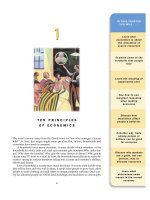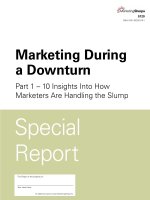Why I’m excited about the Texas pot
Bạn đang xem bản rút gọn của tài liệu. Xem và tải ngay bản đầy đủ của tài liệu tại đây (77.62 KB, 7 trang )
Why I’m excited about the Texas Multi-family real estate market:
Investment opportunities in the Texas apartment industry
A white paper by Keith O. Sanders
September 2011
Copyright 2011 by Keith O. Sanders.
Smashwords Edition
Please send all comments and questions to:
Limit of Liability/Disclaimer of Warranty
This paper has been prepared solely for informational purposes, and it is not an offer to
buy or sell, or a solicitation to buy or sell any security or instrument, or to participate in
any particular investment transaction.
While the author has used his best efforts in preparing this publication, he makes no
representations or warranties with respect to the accuracy or completeness of the contents
of this publication and specifically disclaims any implied warranties of merchantability or
fitness for a particular purpose. The strategies contained herein may not be suitable for
your situation. You should consult with a professional. The author shall not be liable for
any loss of profit or any other commercial damages, including but not limited to special,
incidental, consequential, or any other damages.
Overview
“It was the best of times, it was the worst of times.” Unemployment is 9.1% GDP growth
is anemic, the price of gold soars as fear grips the economy, and yet corporations are
sitting on billions in cash, borrowing costs are at historic lows, and we’re in the midst of
the greatest real estate buying opportunity that the United States has seen in decades.
This paper will highlight several major economic and demographic trends that are
impacting real estate markets across the United States and are accelerating the shift from
homeownership to renting. By illustrating the interplay between these trends I plan to
establish why now is the time to step-up investment in Texas multi-family real estate.
The Financial Crash of 2008
The financial crash of 2008 brought the United States to the brink of economic collapse.
The market slowdown and credit crunch that followed put extreme downward pressure on
all sectors of the economy, particularly real estate. Texas, however, the last state to go
into recession was also the first state to come out of it, showing evidence of recovery in
early 2010. By then, the seeds had been sown for strong growth in the multi-family real
estate industry.
U.S. Housing Market Trends
Real estate investment models focus on the relationship between housing supply and
demand to determine desirability. Below are some of the socioeconomic trends that are
impacting U.S. multi-family housing markets.
Apartment Supply
• Apartment Completions: Per RREEF Research, the U.S. 30-year average for apartment
completions is 153,000 units per year. However, completions of apartment units in 2011
and 2012 are forecasted to reach record-low levels in the U.S. with 28,000 units expected
to be added in 2011 and 36,000 units in 2012.
• The Joint Center for Housing Studies of Harvard University reported that starting with
the “Great Recession,” multi-family housing starts plunged below 100,000 a level not
seen since record keeping began in 1959.
• Local market: David Oelfke, a broker with Apartment Realty Advisors told the Houston
Business Journal, “The population of renters has increased over the last three years
because it’s more difficult to buy single-family homes. During the same time, not many
new Class A apartments have been built because developers could not get financing. [As
a result] class A apartment fundamentals are better than they have been in decades.”
Apartment Demand
• Propensity to shun single-family housing: The second quarter 2011 home ownership
rate fell to 65.9% – a drop of 1.0 percentage point year on year – and the lowest rate since
1998. A review of current literature suggests that due to tightening lending standards,
and lack of confidence in the housing market, the U.S. is becoming a “nation of renters.”
• Echo Boomers: The children of the Baby Boomers, a tribe that is approximately 76
million strong, are entering the work force in increasing numbers. Their age group falls
within the population segment that has a growing desire to live in rental housing.
• Increasing cultural diversity: Nearly 92% of U.S. population growth over the past
decade came from minorities of all types and minorities make up a growing percentage
of those living in rental housing.
• Population Growth: Total U.S. population is projected to reach 325.5 million by 2015.
Immigration and migration trends are expected to push Texas’ population up 8.79% to
27.4 million between 2010 and 2015 compared to 4.61% growth for the United States as
a whole. Texas’ strong population growth will continue to fuel demand for apartments.
What is the Texaplex?
The 2010 census reported that the Texas population has grown to 25.1 million. Texas’
large, diversified economy is dominated by its Metropolitan Statistical Areas (MSAs). Of
particular interest to multi-family real estate investors is a group of three MSAs referred
to as the “Texaplex.”
The Texaplex is the roughly triangular region anchored by Dallas/Fort Worth in the north,
Austin/San Antonio in the west, and Houston in the east. Over 60% of all Texans live in
the Texaplex. Due to the surge in population and job growth – the main engines of multi-
family real estate – the Texaplex is a ripe investment opportunity.
Note: The term "Texaplex" was coined by a Dallas real estate broker as part of a
marketing campaign to counter the negativity of the recession of 2008. Texas is a great
place to do business, and in 2011 is ranked third in the number (51) of Fortune 500
Company headquarters behind New York (57) and California (53).
Snapshot of the 2011 Texas Apartment Market
Texas regional apartment demand is strong, and rental rates continued to rise through the
third quarter [of 2011]. Furthermore, economist Ray Perryman stated in “The Perryman
Report & Texas Letter” that Texas’ short-term outlook is encouraging with continued
population growth and overall job growth expected in the near future.
In conclusion, increased demand and diminishing supply are pushing up Texas’ apartment
occupancy rates and rents.
Potential Investment Strategies
Torto Wheaton Research pointed out that, “Apartment properties vary widely in terms of
age, size, quality, and location, creating a broad spectrum of opportunities and possible
investment strategies and providing greater liquidity than other sectors.” Below is a
summary of strategies that are being deployed to take advantage of the shift in housing
market trends in order to capture property appreciation and cash flow.
Texaplex Strategy A: Build
Purchase raw land, and build new multi-family housing from scratch.
Texaplex Strategy B: Buy
Acquire Class A apartment buildings. These are newer properties with nice amenities
requiring little maintenance. Class A properties are in the greatest demand, and their
prices are being bid up by institutional buyers. Consequently, Class A properties that
earlier in the year could be acquired at a 20% discount on replacement value are now
selling at a 10% discount.
Texaplex Strategy C: Renovate
Redevelop Class B and C apartment buildings. These properties are often “distressed”
due to neglect, over-leveraging, and/or mismanagement, and are prime candidates for
renovation and repositioning. There is less competition for these properties (compared to
Class A) and, as a result, can often be bought at 40% discount on underlying debt. While
this strategy requires more involvement on the part of the investor, it often has the
greatest upside potential.
The Texas Real Estate Market - beyond 2015
The U.S. Census Bureau projects that the Texas population will grow from the current
25,145,561 to 33,317,744 by the year 2030. Employment and housing demand should
grow as well, creating continuing opportunities across all investment strategies for
decades to come.
Conclusion
This paper presented an overview of a number of socioeconomic trends that are sweeping
through U.S. society. Population shifts, increasing diversity, reluctance to embrace
homeownership, and other factors have created an imbalance between supply and
demand in Texas’ apartment markets. “We are in the early days of a beginning boom in
apartment construction. The window for rent increases is wide open right now and will
remain open until the new communities come online in 18 to 24 months.” Dr. Mark G.
Dotzour, Chief Economist, Real Estate Center at Texas A&M University.
This is why I’m excited about the Texas multi-family real estate market.
Email:
About the Author
Profile
Keith Sanders is an articulate, people-oriented professional who moves effortlessly
between cultures and organization levels. He has acquired more than 10 years of
international experience, strong oral & written communication, research and
interpersonal skills. By creatively managing teams, delivering presentations, and
negotiating strategies, he has successfully coordinated projects from conception to
completion.
Keith co-founded the Foreign Entrepreneur Promotion Committee, a non-profit
organization founded by independent businesspeople with the support of local
governments, trade organizations and consulates. Its signature events included:
• Hospitality program created for the Junior Chamber International World Congress in
Japan. The World Congress was a leadership development conference, which brought
together over 3,000 business and government leaders from more than 30 countries.
“When I arrived in Japan I knew no one, and had nothing but a suitcase, two thousand
dollars, and a positive attitude. By the time I left I had made life-long relationships,
created a successful business, and co-founded a business-networking group. I am now
using my skills and experiences to develop mutually beneficial opportunities in the
Texas real estate market.”
Keith holds a Bachelor of Business Administration degree from the University of
Houston and resides in Houston, Texas where in addition to his full-time job in business
development he has rehabbed and manages a small portfolio of single-family homes.
Objective
Involvement in commercial real estate development projects that would include analysis,
due diligence, acquisition, construction, redevelopment and marketing of multi-family
properties. Strong interest in repositioning distressed multifamily properties: (1) identify
suitable investment targets, (2) renovate and provide other value added improvements as
needed, (3) improve the resident profile and/or occupancy, and (4) other tasks as required
in order to increase asset value.
Email:









